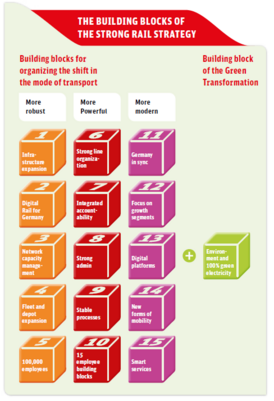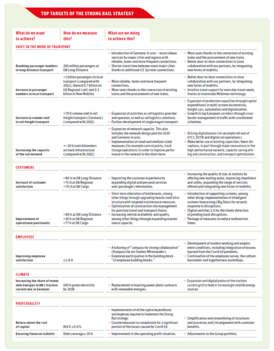Strong Rail strategy
Our inner ambition
Our inner ambition is to ensure that Germany has a strong rail system. Building a strong rail system will help our country to overcome existential challenges:
- For people. By 2050, almost 85% of the population of Germany is expected to live in metropolitan areas, compared to 75% in the early 2020s. In concrete terms, a strong rail system for people means a doubling of passenger numbers in long-distance rail passenger transport and thus five million fewer car journeys and 14,000 fewer air journeys in Germany per day than at the start of the 2020s.
- For Europa. Climate protection, jobs, economic growth, social prosperity: much depends on Germany’s and Europe’s transport routes remaining future-proof. Strong Rail is the necessary link between East and West, and North and South. In concrete terms, Strong Rail for Europe means: working together to realize a European network.
- For the economy. The demand for the transport of goods will continue to grow steadily in the coming decades. In concrete terms, Strong Rail for the economy means: growth in the modal share of rail freight transport to 25%. This corresponds to about 13 million fewer truck journeys per year on German roads.
- For the climate. Today, no motorized means of transport is as climate-friendly and takes up less space on average than rail. In addition, no other means of transport is as electromobile – and therefore as low in greenhouse gases and pollutants – as rail, which holds the largest market share of e-mobility in Germany. No other mass transport can achieve a 100% share of renewable energies as quickly – by 2038, we will have converted the DB traction current mix to 100% eco-power. In concrete terms, the shift in the mode of transport towards a strong rail system for the climate means savings of up to 10.5 million t CO₂ per year, which corresponds to the annual CO₂ footprint of around one million people in Germany.
Implementing Strong Rail
We have set ourselves the goal of harmonizing the economic, social and environmental factors with our business goals. Sustainability is anchored in our guiding principles and is an integral part of our DNA.
With the Strong Rail strategy, we have set the course for a shift in the mode of transport and are expecting to create additional capacity, increasing product quality and improving customer satisfaction. In order to create the necessary conditions for the shift in the mode of transport, we have identified three strategic areas within the Strong Rail framework:
- More powerful: In order to be able to achieve a high and sustainable performance level in the long term, we will also carry out structural changes.
- More robust: We are committed to the extensive expansion of performance-critical capacities. With a long-term focus on growth and technological innovations, we are creating the necessary capacities in infrastructure, vehicles and personnel.
- More modern: We will increase the pace of innovation for our customers. The integration of new and innovative forms of mobility and the use of smart services and digital platforms create clear added value for our customers. In this way, we take into account rising customer expectations and create an attractive offer for sustainable mobility and logistics, both in cities and rural areas.
For each of these three expansion areas, we have identified five central issues, which we call building blocks. The key criterion for selecting the building blocks is their importance across business units for our goal of a strong rail system in Germany and therefore also for the Federal Government’s transport and climate policy goals. This has resulted in a total of 15 building blocks to help us to organize the shift in the mode of transport. They are supplemented by building blocks specific to each business unit.
However, the shift in the mode of transport to rail can only achieve its full potential if the railway also continues to strengthen and expand its climate-friendly operations and other environmentally friendly advantages. DB Group’s Green Transformation is therefore a central requirement for the effectiveness of the shift in the mode of transport. To live up to the importance of this topic, we have defined another overarching building block through which we aim to ensure the effectiveness of the shift in the mode of transport. Together, these 15 +1 building blocks form the strategic framework of our business alignment.
Strong Rail targets
Concrete measures are at the basis of every building block of the Strong Rail. A “construction manager” was named for the operational management of each building block, who is accountable to the Management Board for designing the measures and their operational implementation. The building blocks were incorporated in DB Group’s mid-term plan. We monitor contributions to targets with key performance indicators. This measurement is ongoing, and is managed and monitored within the Strong Rail Board, a specially created body, supervised by the Management Board and the Chairs of the business units of the Integrated Rail System. The basis are the transport policy sector targets of the Federal Government.
Outlook: Top Targets Strong Rail
Anticipated development | 2022 | 2023 |
Passengers (rail) long-distance transport (million) | 132.0 | >155 |
Passengers (rail) local transport (million) | 1,605 | ~ 1,900 |
Volume sold rail freight transport (Germany) (billion tkm) | 59.6 | ~ 62 |
Train kilometers on track infrastructure (Germany) (million train-path km) | 1,133 | >1,130 |
Customer satisfaction DB Long-Distance (SI) | 74.8 | ~ 77 |
Customer satisfaction DB Regional (rail) (SI) | 70.1 | ~ 70 |
Customer satisfaction DB Cargo (SI) | 67 | ~ 61 |
Punctuality DB Long-Distance (%) | 65.2 | >70 |
Punctuality DB Regional (rail) (%) | 91.8 | >92 |
Punctuality DB Cargo (Germany) (%) | 66.1 | >67 |
Share of renewable energies in the DB traction current mix in Germany (%) | 65.2 | 67 |
Employee satisfaction (SI) | 3.9 | ‒ |
ROCE (%) | 2.8 | ~–2 |
Debt coverage (%) | 13.1 | ~ 6 |
- Volume figures for rail passenger transport should continue to stage a noticeable recovery in 2023.
- We also expect positive trends in rail freight transport volumes.
- Developments in volume produced should be stable, also in order to avoid any further burden on the infrastructure.
- Following the significant deterioration in customer satisfaction due to operational quality in 2022, a consistent level is expected for 2023. The background to this is the continuing challenges in relation to operating quality. At DB Cargo, we expect the customer satisfaction score to be significantly lower at the next measurement in March 2023 due to the significant drop in punctuality in 2022.
- Punctuality is expected to improve in 2023. In order to achieve these goals, quality-related measures will be further promoted and intensified, particularly with regard to structurally sustainable improvements, with a focus on infrastructure. However, achieving punctuality targets is a major challenge due to the further increase in volume of transport and capacity and aging problems in infrastructure.
- We will continue our measures to reduce the greenhouse gas intensity of the DB traction current mix in Germany through a gradual increase in the share of renewable energies.
- In 2023, the results of the employee survey will be analyzed and processed as part of the follow-up process. In autumn 2023, the culture barometer will be used as a random sample survey. The target value of the compass index 2023 is 52%.
- Due to the expected significant deterioration of adjusted EBIT, along with a simultaneous increase in capital employed, the ROCE is expected to decline.
- Debt coverage is also expected to decline significantly as a result of the expected weaker operating profit.

